Five years flies by very quickly (when you are having fun). I had hoped that this post would be titled ‘The Seventieth Birthday Stag’ but he did not emerge from his lair during my recent sojourn up the bush to check how my hunting camps had fared from the terrible bush fires of earlier this year.
I am still not fit enough for this sort of hiking after my spinal fusion but I spent four days at it nonetheless – much harder work than in times past and nonetheless only managing a daily total equal to about half my ‘normal’. They said it would be twelve months. I hope this is not a permanent situation – it informs me at least that I am going to have to bite the bullet on a new knee, soon. So many operations. I am tired of them. I hoped to make this one last until I could just have an artificial cartilage. They have begun testing in the States.
(Update 02/08): Yesterday we had a different instructor at the gym. She had us doing new (to me) ‘pilates’ (esp leg) exercises. I was astonished to have no pain at all in my knee for over half the day even while going around the lambs on the steep hill at the back of the farm – after over a year of constant pain every time I stepped on it. Tip: Try every kind of exercise before you reach for the knife, which might not work anyway. Surgeons mostly just want to make a ritzy living. I will be seeing the girl on a personal trainer basis to see if she can ‘fix’ this knee, meanwhile I am practicing what of her exercises I can remember and believe worked.)
Each day just walking (not hunting) I saw at least two deer (some days four) I could have easily taken with my rifle, mainly smaller stuff, spikers or hinds. If I can chamber a round, draw a bead on the deer and count to 1,2 seconds I clearly could have pulled the trigger and made it a dead deer. These days I usually don’t shoot unless I have some particular reason. Of course I encounter more deer than I could have had a reliable shot at. That goes without saying. (If you go where there are lots of deer and the country isn’t too thick, you should be seeing lots of deer too. By the signs everywhere there are lots of them out there. If you aren’t you are doing something wrong – probably wearing camo for a start!)
PS: There is a spot where I sometimes go (and No, I am not going to tell you where, but there are lots of them) where I see many more deer than this in a day, sometimes in groups of over twenty (!) – but it is only a smallish area, suitable really only for a day hunt. I am more interested in walking larger distances, ‘sight-seeing’ and in the camping out experience than in seeing/shooting lots of deer. If you canoe the Victorian rivers in the summer (or walk/cycle along 4WD tracks instead of driving) you will find many similar places (eg by the huge amount of signs at their drinking spots!) – and by paying attention to your nose.
I would have taken a decent stag (I guess – though they are beautiful) but one did not present itself to me during the daylight hours – though on two separate nights (the first and the last) one visited me at my tent. The first thing I knew was the overpowering smell of stag (or Spot barking, usually later – he curls up in his bed a lot). When I switched the head-torch up to a suitable level of brightness there was a stag not twenty yards away (on each occasion). My loaded gun is always to hand on such camps (because of the risk from wild dogs particularly with Spot along) but I have no temptation to shoot a magnificent animal at such a disadvantage – as in the car’s headlights. Fortunately they have never charged, though I was knocked aside by one once as I was standing in his way.
I think the wild dog numbers are down at the moment because of the fires. They would have had a field day cleaning up the corpses followed by very lean times indeed where many starved. The few dead deer I did find had not been touched even though they were days old – which is unusual. Of course the bird life is down drastically too, and wild dogs must pay attention to the behaviour of (eg) crows to indicate to them a ready source of food.
Neither do I see any point in leaving 8-10 dead deer just lying around in the bush completely untouched – like some I found, even though they are still quite numerous. Apparently there are still plenty of young folks who would like to harvest them and enjoy lugging all the meat out, so I will leave most of the deer to such aspiring hunters.
You have to be quiet in the bush if you expect to observe its shier denizens. I have explained this again and again. Even with this terrible limp I clump along a lot quieter than many young people who might be quite mystified that I have the opportunity to shoot 2-3 deer a day without even looking for them at dawn and dusk, when I prefer to read a book and drink a cup of coffee – especially as that knee is damned sore! I would be able to shoot as many as six a day if I actually hunted for them at the right times as well. When you get up on the ridges and gully tops actually looking for deer, you really ought to be seeing a few every dusk and dawn or you are doing several things wrong – at least where the signs (eg lots of droppings, tracks etc – and smell!) indicate large numbers of deer.
Seeing lots of deer has nothing to do with ‘cheats’ like camo which I eschew. Only wool for me. It is light, safe and always warm, and always smells good. Just ‘quiet foot steps’ and don’t stink! And pause. Look, look, look. I can smell a deer easily 200 paces away. It stands to reason that if you use deodorant, or wear synthetic clothing so that you smell just awful after five minutes’ exertion any deer will smell you a mile off too, and be gone.
Practice your sense of smell. Sniff deeply at wallows, preaching trees, rubs, dead deer etc. Train your brain to recognise those smells. You should easily be able to distinguish the different odours of stags and does. As you walk along, always breathe through your nose. Take deep breaths with your head well up from time to time to really ‘test the air’. When there is deer scent s/he is within a couple of hundred metres (probably closer – but invisible), then tread very lightly indeed and look, look look, gazing out through the vegetation.
You must know how good they are at standing behind cover as they do when they honk constantly at you but there is no-one there! Move very slowly and look very closely. When you shoot a deer in the chest (and it runs off) instead of looking for it with your eyes (you will find it anyway within a couple of hundred metres) search for it instead with your nose, paying careful attention to the wind direction. Do so a number of times. It isn’t going anywhere and it is very good practice for you. I have many times in over thirty years’ hound hunting located other people’s deer which they couldn’t find by eye by doing this. Train your nose!
Between two largish flats where I often camp I often pause and sit on this rock (below centre)
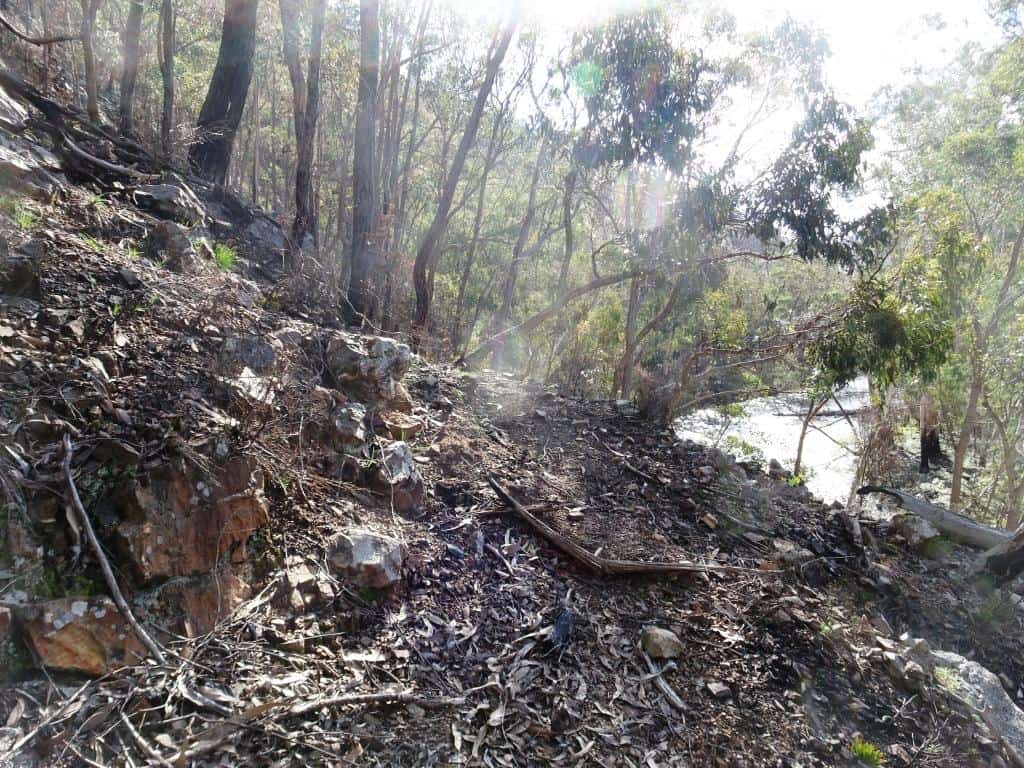
and just watch the river go by (below) – and sometimes a deer on the opposite bank too. On this occasion a platypus rose continually in exactly the same spot, something which they rarely do. There must have been something down there he was worrying at. Four times he popped up down below me and I snapped his photo, then he just drifted off down the stream and out of sight, which is what they normally do. He would be clearer save that he is mostly underwater.
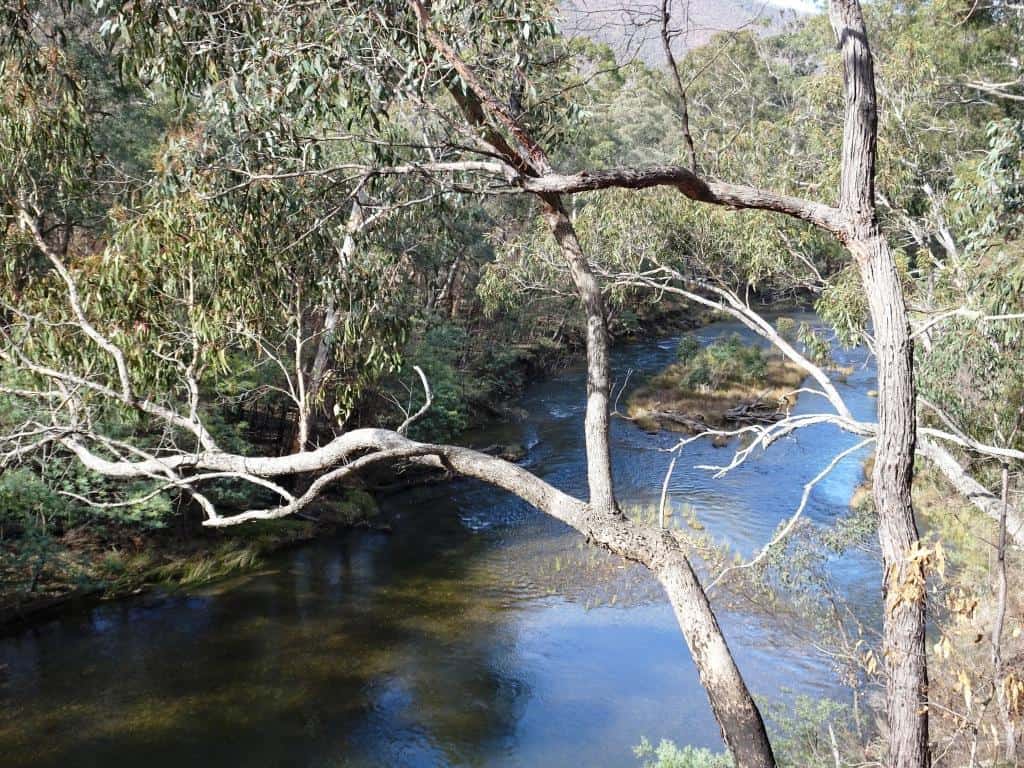
There he is:
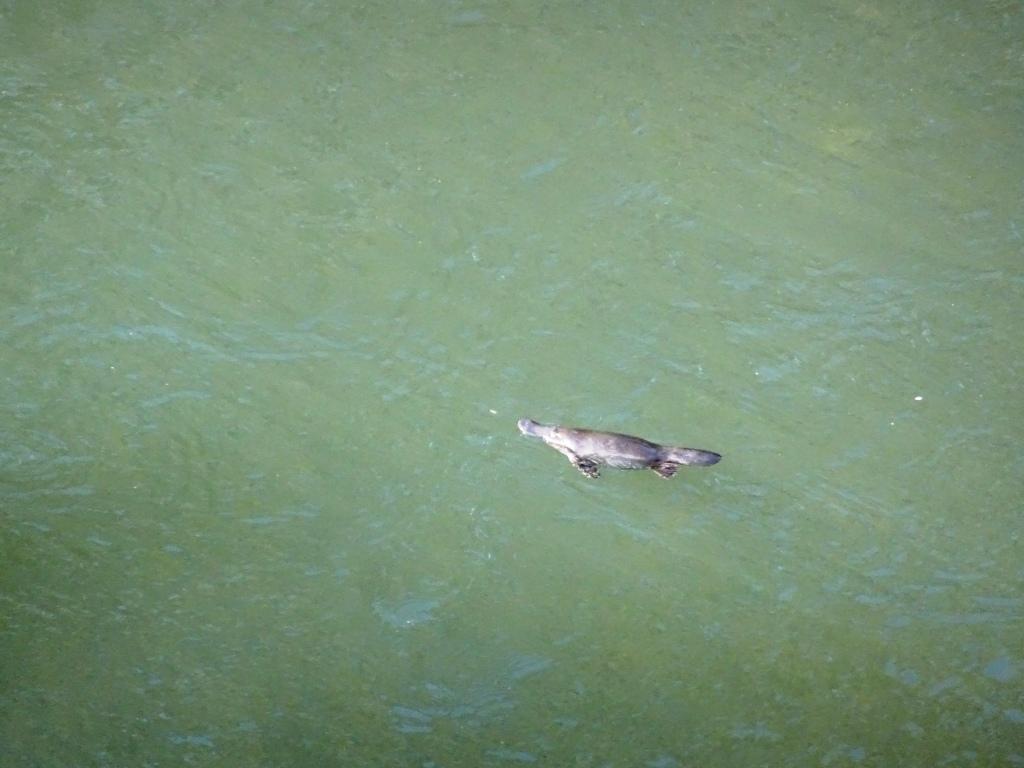
Closer…
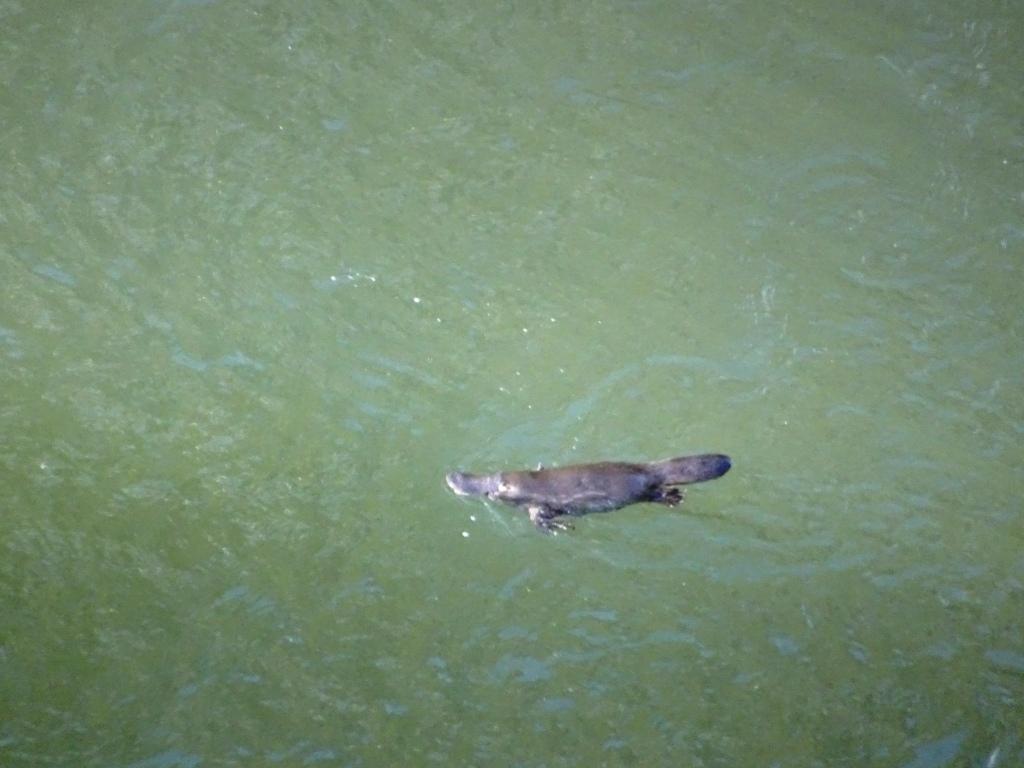
And closer…
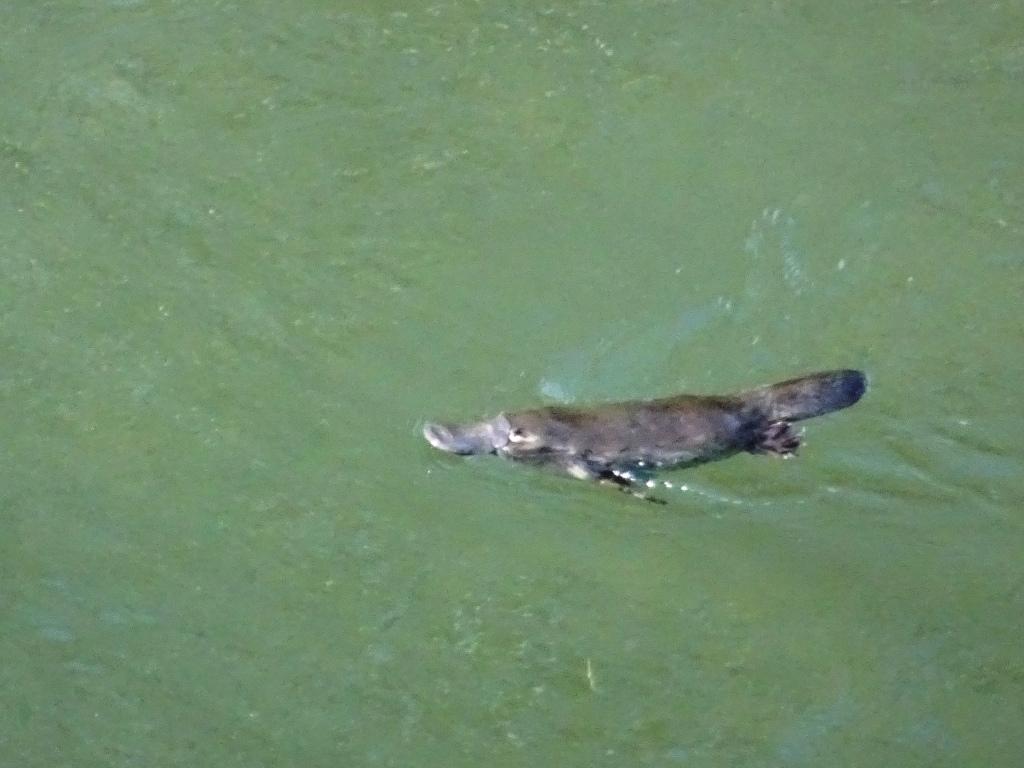
And off he goes!
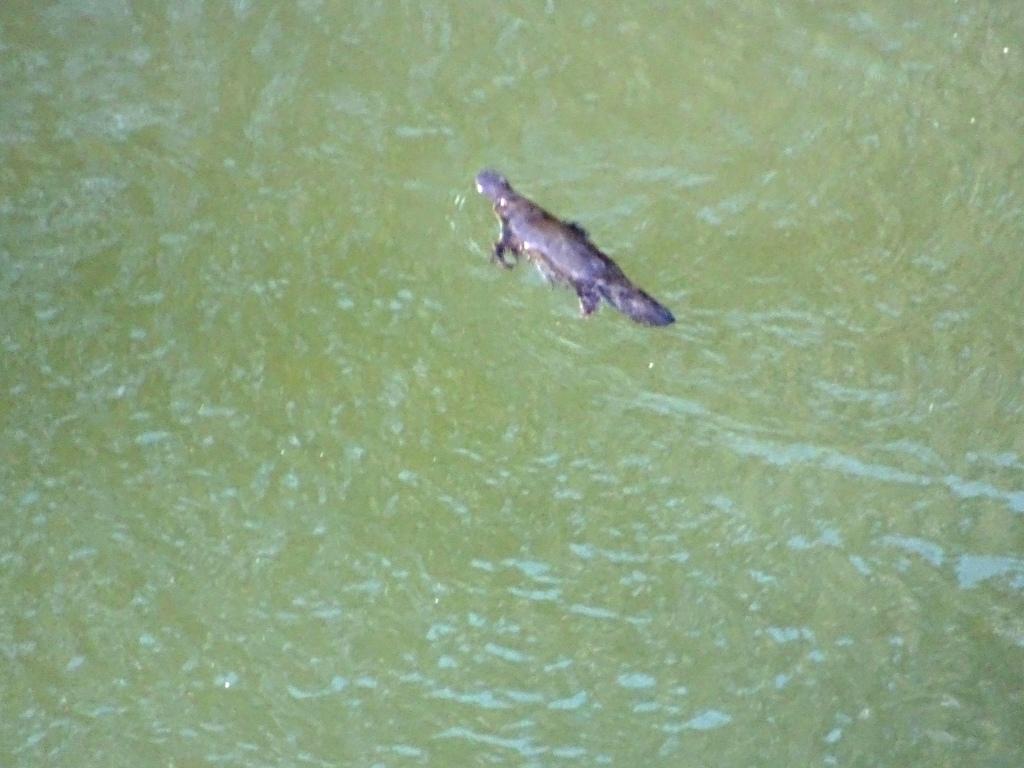 I often see one when I am fetching water or washing up at my camp just upstream of here – or just as likely a deer which is hard to ‘bag’ with just a pot, cup and spoon. I think I have seen more deer washing up than in any other place! I should invest in a heavier calibre spoon. The old one has ‘taken’ heaps of deer though. I just point the spoon and pull the trigger. ‘Bang’ I say, and off the deer goes.
I often see one when I am fetching water or washing up at my camp just upstream of here – or just as likely a deer which is hard to ‘bag’ with just a pot, cup and spoon. I think I have seen more deer washing up than in any other place! I should invest in a heavier calibre spoon. The old one has ‘taken’ heaps of deer though. I just point the spoon and pull the trigger. ‘Bang’ I say, and off the deer goes.
In this kind of bush-stalking sambar deer you don’t get very long to gaze at an individual deer, nor is it ever very far away. I guess you put it up 20-50 yards away. I have bumped into sleeping deer a few times. Once I actually went to step over one. It honks and is off. You have maybe a couple of seconds to decide to and to shoot it. A 12G shotgun would work well and pose less danger than a rifle. Perhaps lighter too. Buckshot would make certain of it, but it is not ‘approved’. Why do they think it is so named? A telescopic sight is not much use, and you would likely damage it pretty soon – at least the many knocks and drops my .308 usually takes over a couple of days would ruin any scope I know of. The iron sites are fairer to the deer and more reliable anyway. And you can see what you are shooting at.
As I am there to hunt deer and not to photograph them, I rarely get a photo opportunity. It takes a lot less time to load and point a gun than to turn on and point a camera. The deer would be gone just about every time. Now and then you are sitting down somewhere and a couple of deer will wander out of the treeline on the opposite side of the river to have a munch. It would be pointless shooting them there as it might be half a day or more up or down the river to a crossing point – if there is one at all. Somewhere like this where the platypus was. Some sweet clear grass (and forbs) over there. Deer love forbs.
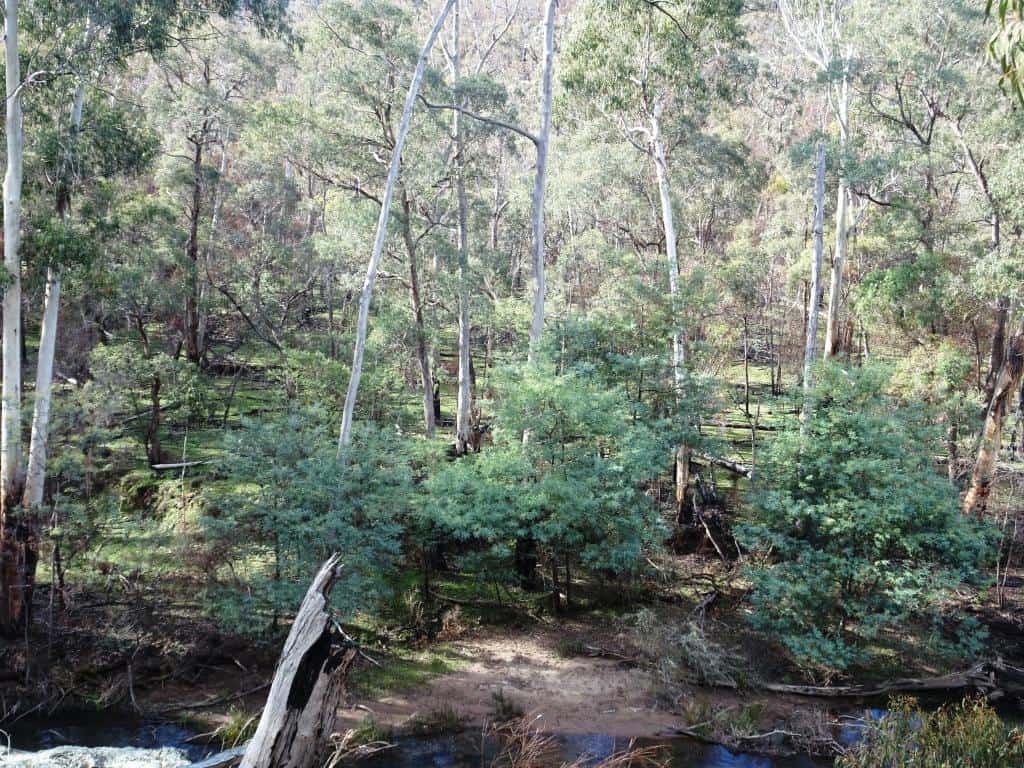
You know, like this:
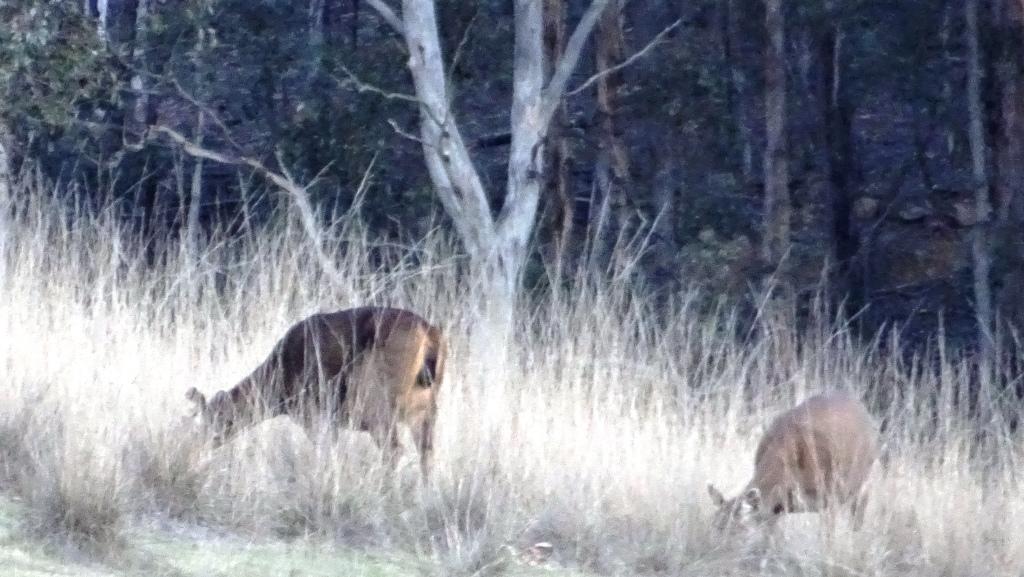
Again does and young stuff. If you want to hunt stags (reliably) you will have to go look for them. Or cheat. As most do. Lying up on game trails or wallows is the least of it. So often in forums I notice people ‘proudly’ posting photos of stags they have ‘shot’ where it is clear that the animal is on the edge of a track or road, or way out in the middle of a paddock.
Some are not so careful to conceal their malfeasance. A young bloke I used to take hunting recently posted such a photo. The animal was clearly lying dead in the middle of a paddock around mid-day. Yeah, sure. You could tell by the shadows or lack of them. If you lie in bed that late you will not catch a stag in the middle of a paddock. This young hunter had even forgotten to change (back) into his hunting boots. And his shoes were dry even though the grass was wet, so he had only just stepped out of his car to photograph an animal he had unfairly shot over the lights the night before and let spoil (by not gutting it quickly) so he could get a photo-shoot the next day! He was also far too neat for a man who had spent the day hunting. I was embarrassed for him actually.
If you want to take stags (reliably – some will just pop up as you walk along), you will have to go look for them, and to get to them you will have to walk through all the does and young stuff who camp lower down (their food demands are greater – all that growing to do) and so act as a signalling device for the mature stags. I notice too that stags are much less prone to honk. They will more often just watch you quietly walk on by. The survivors no doubt develop this ability. When you do spy one (out the corner of your eye) load your gun and make it ready to swing up quickly before you turn to look as he will bolt the second your eye rests on him. They will often be found alone or in groups of 2-5 animals quite high up (relatively) but often in very thick stuff which will act as a screen and a burglar alarm. It is easier in association with a mate to bolt them out with dogs of some sort, just like flushing foxes from patches of cover. There are pairs of old guys out there who have garages full of antlers taken in this way.
Four out of eight of my camps were just melted ruins like this with very little that could even be salvaged. Surprisingly I did salvage a single pot I have owned since 1970 and an aluminum plate I bought in 1963 and used when I was droving when I was still at school! I actually brought the plate home with me! A sentimental journey.
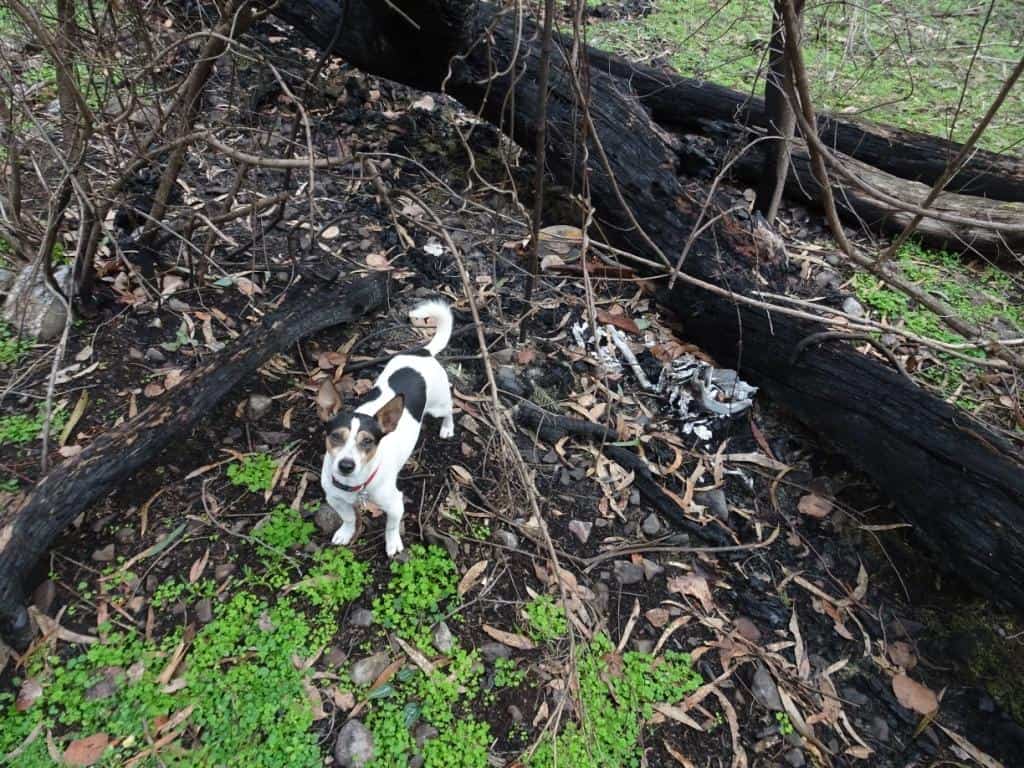
As I had positioned the camps about 1 1/2 hours walk from each other up the river and I lost three in a row, this means I have a gap of nearly 6 hours. I will probably re-establish (at least) the middle one of the three during a canoe trip over summer as that is too much of a gap for me to be comfortable with nowadays. Of course each camp could act as a base from which to do day hunts (out to the sides) or overnight fly camps likewise so that I would cover a lot of ground laterally as well as lengthwise. There are some very promising side ‘gullies’ joining this river. Some of them days’ long.
You have to learn where they begin to run again higher up, and where there is a suitable flat spot high up for a fly camp – or else take a hammock, which is a great idea actually. A hammock should weigh no more than approx 150 grams. Often there is water very near the top (one reason stags camp nearby!) Lower down the water often seems to go underground for sometimes kilometres before popping up again nearby the river junction. There must be a hydrological and geological reason for this. It would help you find gold if you made a study of it.
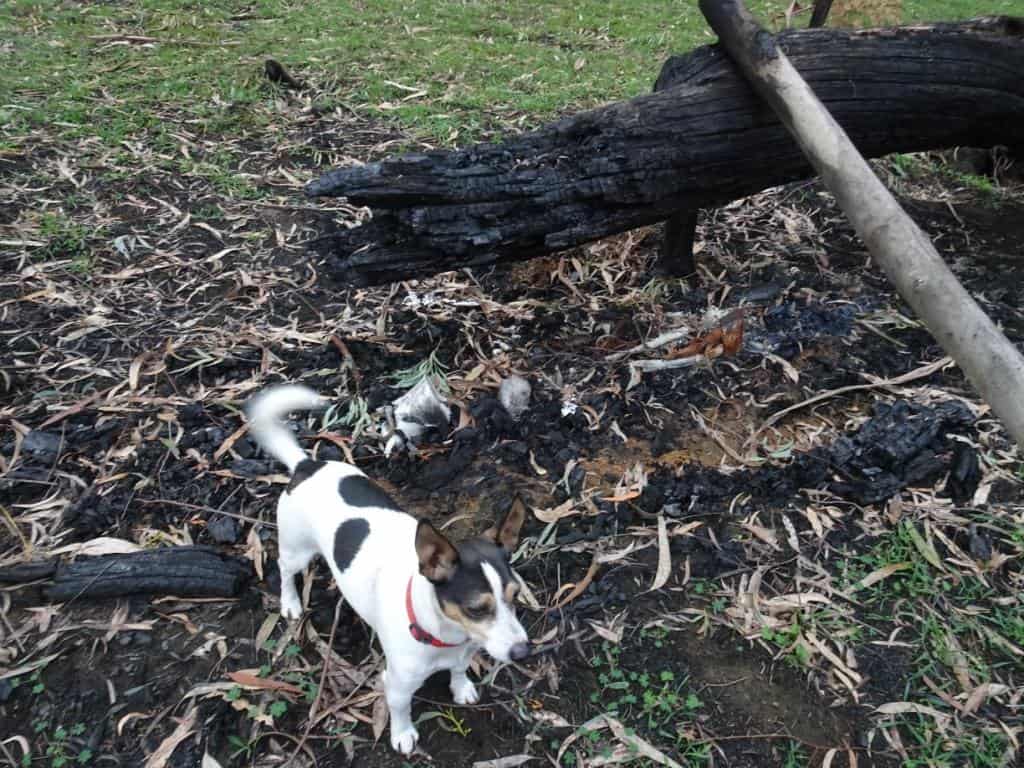
I will miss those huge Tyvek shelters, 16 feet on a side. They were just so protective and roomy. As you can see from the two photos below I had lain the black drums next to or under large logs where they would (likely) not be found (in dampish spots, and above flood level). I suspect they were not found, but it is also more than likely that the quality of person who makes the large effort to undertake multi-day backpack hunts is not likely to interfere with what might (after all) be another person’s safety or survival. It is the ‘golden rule’ much neglected nowadays. ‘Do unto others’…Most of the drums included a statement that I did not mind if others used the facilities provided they made an effort to replace anything they may have used. You can get an idea from the photo below what the shelters were like. I will probably make rather smaller ones in future as it is usually just me or perhaps two of us.
I think I will take in a few (approx) 1 metre square sheets of (green) flat iron, or a square of fire blanket material if it will take dye. Have to experiment. In future I will bury the drums (on their side) in an open, grassy spot just to ground level so they are easy to get to and just lift out. I will place the sheet over them and lay stones around it to keep it down – or peg them if I use blanket. This way a future fire (which will be traveling very slowly over well-chewed grass should stop at the edge of the sheet and leave my drums alone. They will be easier for others to discover but you have to trust the good offices of strangers sometimes too!
That’s me with my young American friend Steve Hutcheson from the Dusky Track relaxing in one way back in 2013.
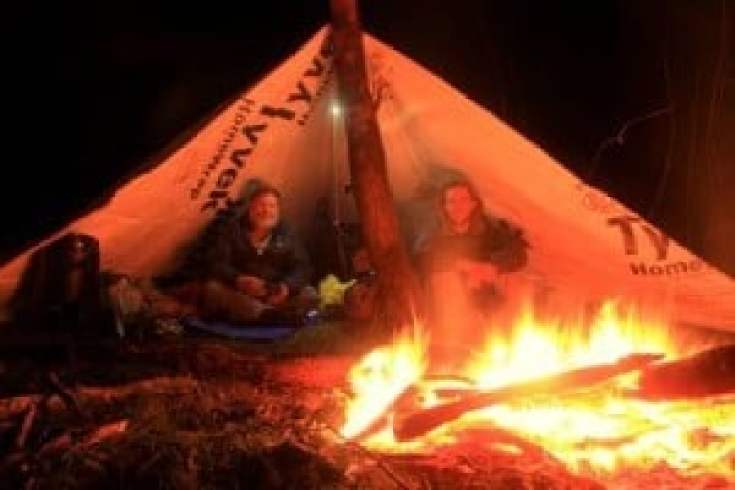
I do love a campfire. Here is a photo taken on my second night out which happened to turn out quite nicely thanks to a clever feature of my new camera. A wondrous shower of sparks.
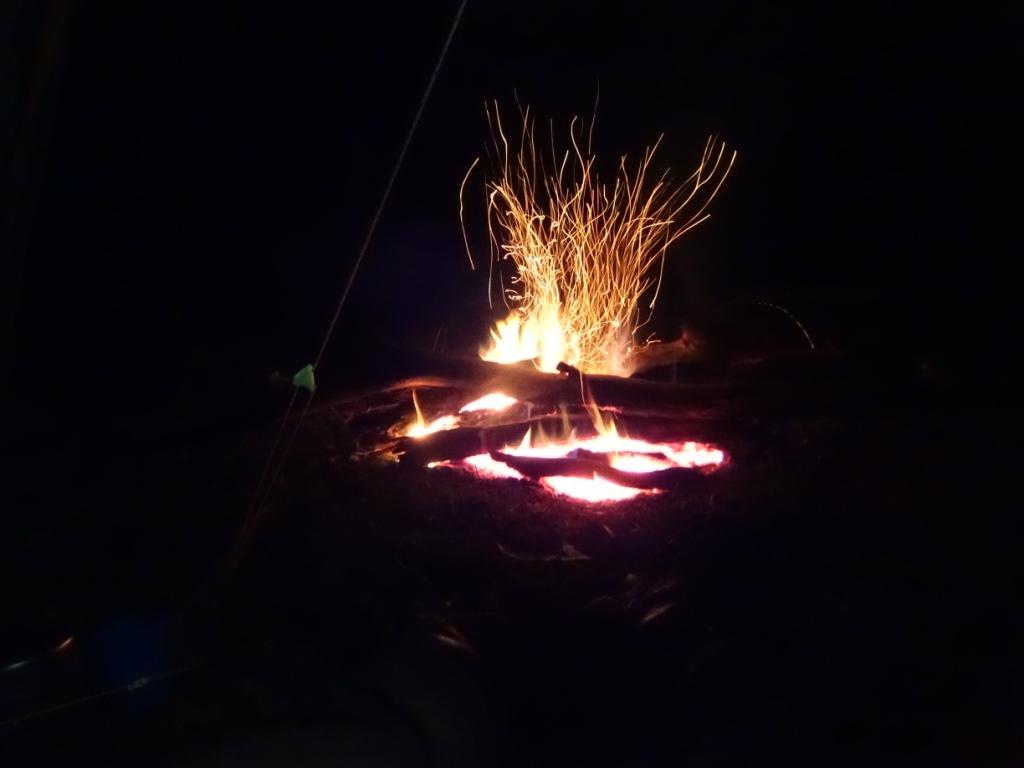
I even made a video of it which certainly showcases what serene beauty there is in such wonderful wilderness camps.
This is the view from the other side, looking in. Not such a serene beauty I know! But note the wool clothing – and that one is not tidy at the end of a day’s hunting!
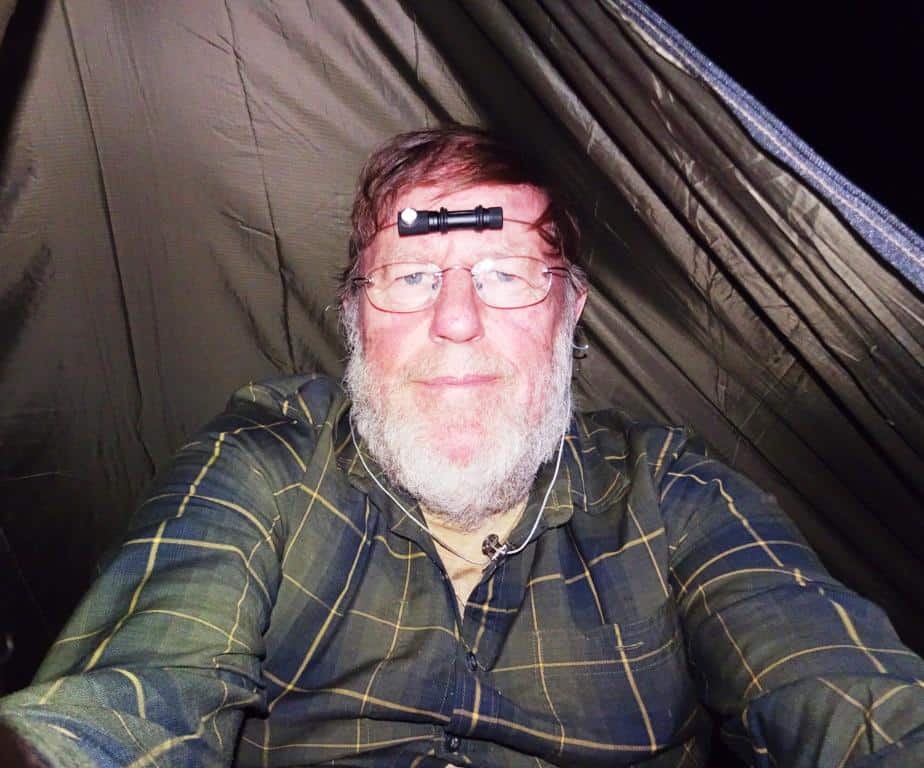 I am sitting in is my little sub 200 gram ‘Poncho Tent‘ which I have probably tested enough times now. It is big enough for Spot and me but I am somewhat vertically challenged. Even so I could use just a little more length and width to be really comfortable and feel completely safe (dry) whilst still being able to be use it as a poncho. I will extend this one a bit even though that won’t look quite so neat as a completely fresh one would (but will save money) which doesn’t grow on any of the trees around here either!
I am sitting in is my little sub 200 gram ‘Poncho Tent‘ which I have probably tested enough times now. It is big enough for Spot and me but I am somewhat vertically challenged. Even so I could use just a little more length and width to be really comfortable and feel completely safe (dry) whilst still being able to be use it as a poncho. I will extend this one a bit even though that won’t look quite so neat as a completely fresh one would (but will save money) which doesn’t grow on any of the trees around here either!
I figure to add less than 50 grams. That will be just enough (I calculate) to fit two very good friends in (me and Dell at least) and yet still weigh (probably) less than 300 grams all up including tie-outs and pegs. Another 25-50 grams or so for an ultralight floor. This is using the one-ounce per square yard material I currently have. Dutchware used to call it Xenon Sil but he doesn’t seem to have it any more. I have discovered some material which claims to be .7 ounces per square yard and yet still is 2500mm waterproof. I will get a sample and try it out.
You have to be careful when laying out your ground sheet that none of it protrudes under the edge of the tent. A tiny pocket handkerchief of such material protruding will easily collect a glass of water when a shower comes by and redirect it right under your bum. A wet arse in the middle of the night is annoying. Polycro really is a great ground sheet material though it will need to be checked for holes (and replaced) oftener than something made of lead!
I am also thinking about making my Deer Hunter’s Tent just a tad larger, so after I have prototyped it in Tyvek I may use the new material to make it. In this new material (without a floor) it should weigh less than 300 grams all up too. The Poncho Tent is not quite wide enough to sit inside facing towards the fire and keep your legs dry when it is raining. (Roof too low). You have to sit side-on which is inconvenient. The Deer Hunter’s tent is wide enough for two people (and two dogs) to sit side by side facing the fire and (all) have dry legs in the rain. I do love the sound of the rain on a tent. Of course I would, as I grew up in one.
I also want to revisit the Forester Tent. I never really did finish the prototype. While I was away I spent a couple of nights in older versions of my Tyvek shelters. Their openings gave me an interesting idea to try out on the Forester. More about that later.
I will have a new/old design for my replacement shelters. You can see it/them here: https://www.theultralighthiker.com/2019/09/06/two-great-poly-tarp-configurations/
I have no idea whether I will finish all these projects or be able to offer them to others for purchase. I will be 70 in a few days – as you may have gathered from the title. Thank you for your good wishes on that occasion. Della really thinks we have ‘enough money’ and should just ‘smell the roses’ (which she likes – I loathe the wretched things!) or at least not begin a new financial venture, but time will tell. You certainly don’t need much money anyway to be deliriously happy all your life. A wonderful woman help though.
This is a spot I often used to camp in my big Tyvek shelters. It got pretty badly burned, as you can see. So much timber down. It makes walking so much slower and more difficult. The bird song (which had been coming back here and there after the 2006 (?) fires has ceased again. I also find this really tragic. The current land managers have no idea at all. They are driven by some wicked green agenda which has no basis in practical reality. The result is the episodic widespread destruction we see here.
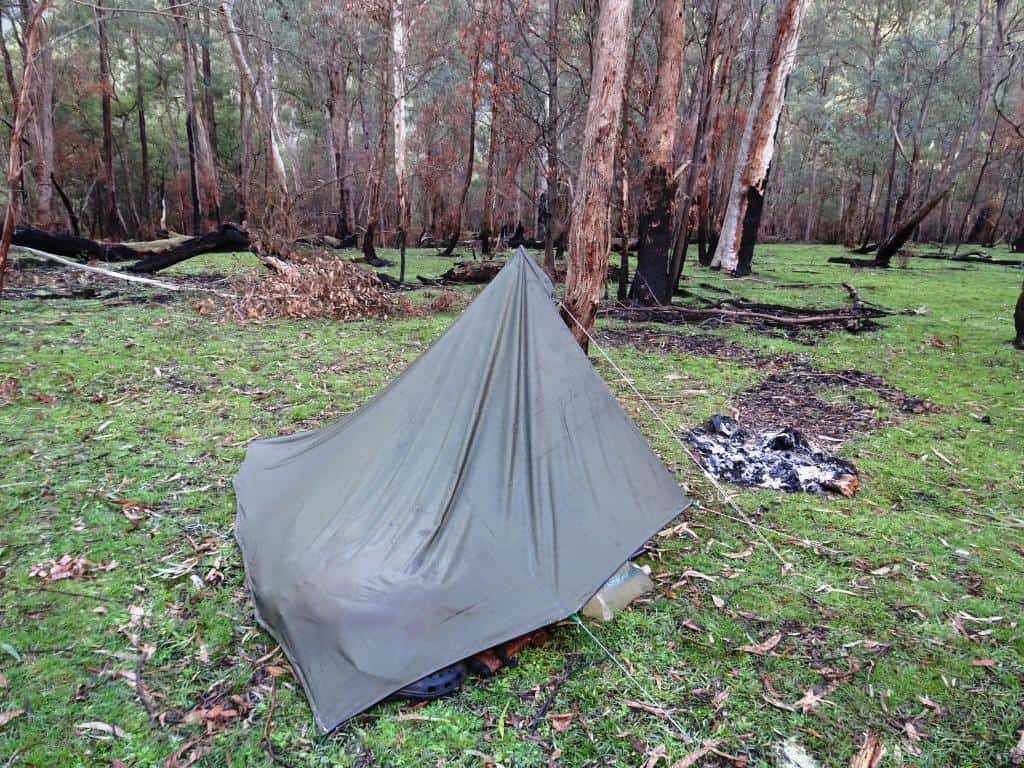
Several different angles.
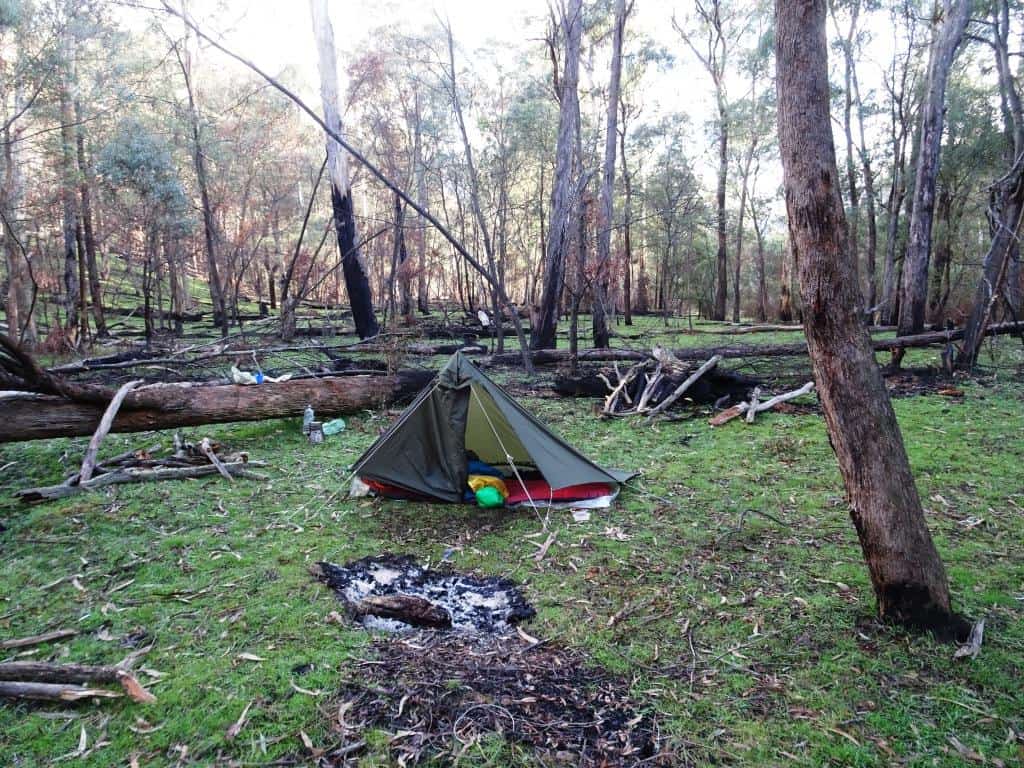
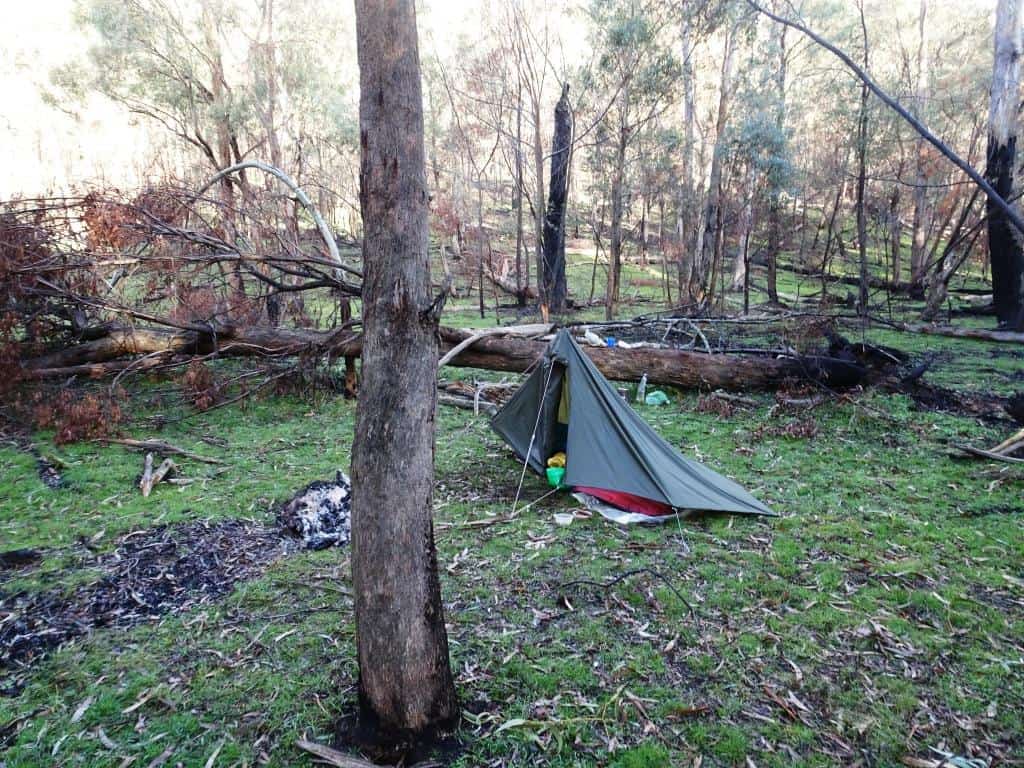
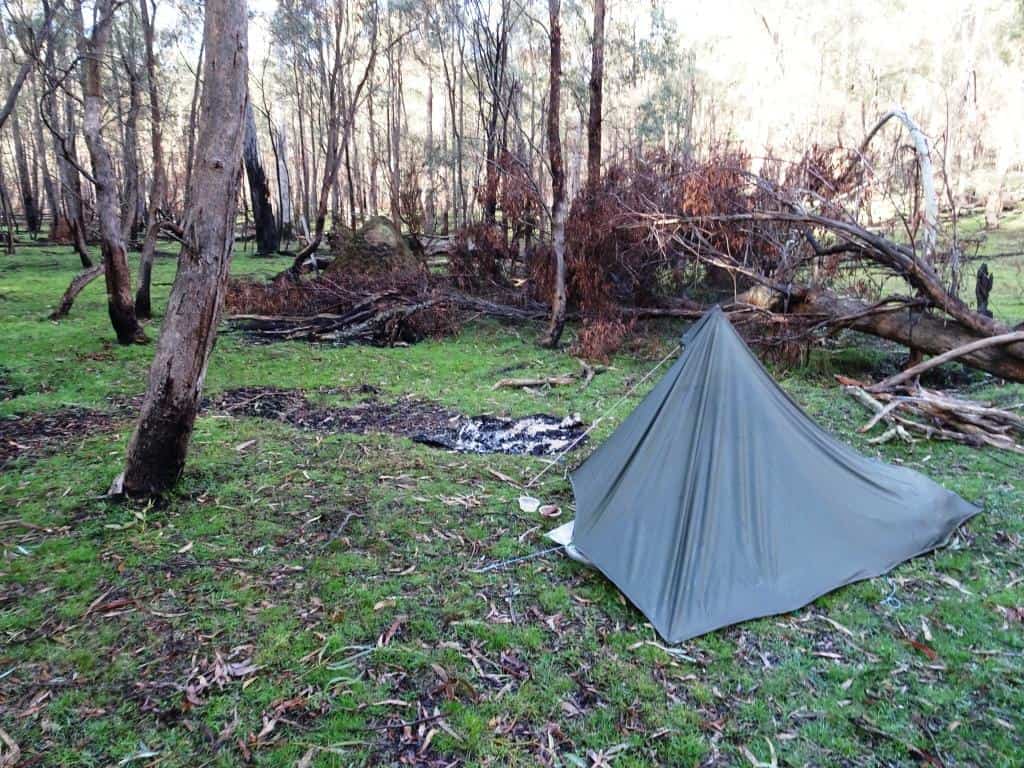
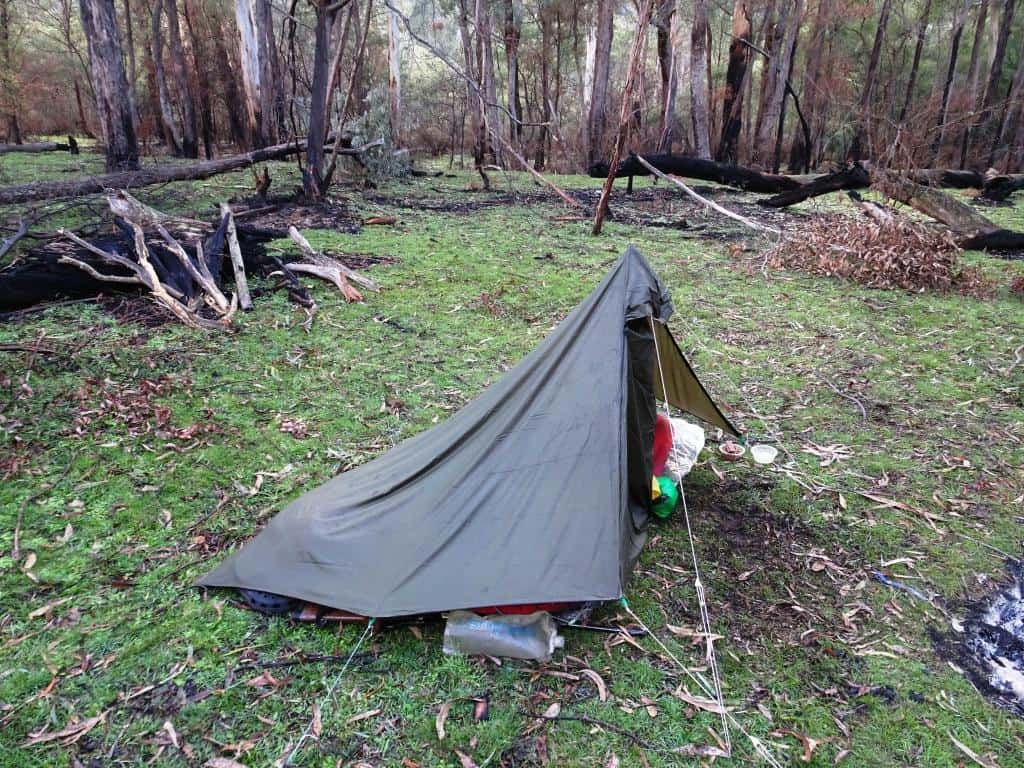
So much timber down everywhere make it so much more difficult to walk. This is what it used to look like. The tree my gun is leaning against is the same tree in all the poncho tent photos above.
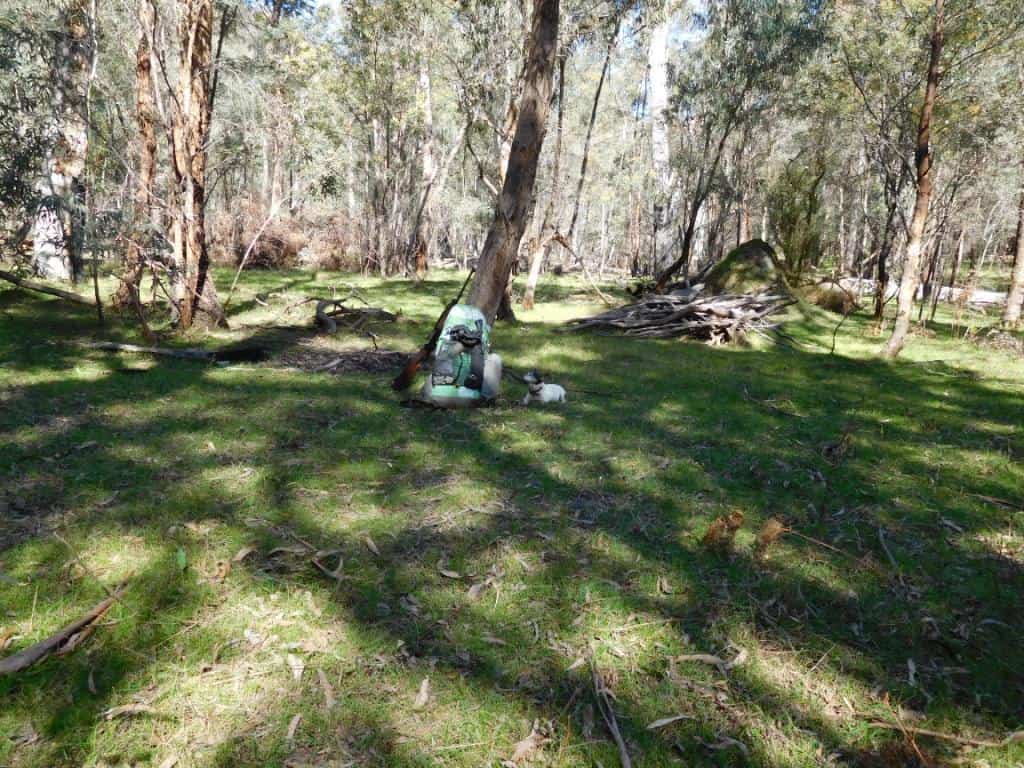
People ask me what I carry. Here are the contents of my poncho tent after I took it down. It’s not a lot for a trip of what might turn out to 5-6 days’ hunting is it? The gun is leaning against the log I am sitting on while I roll up the poncho.
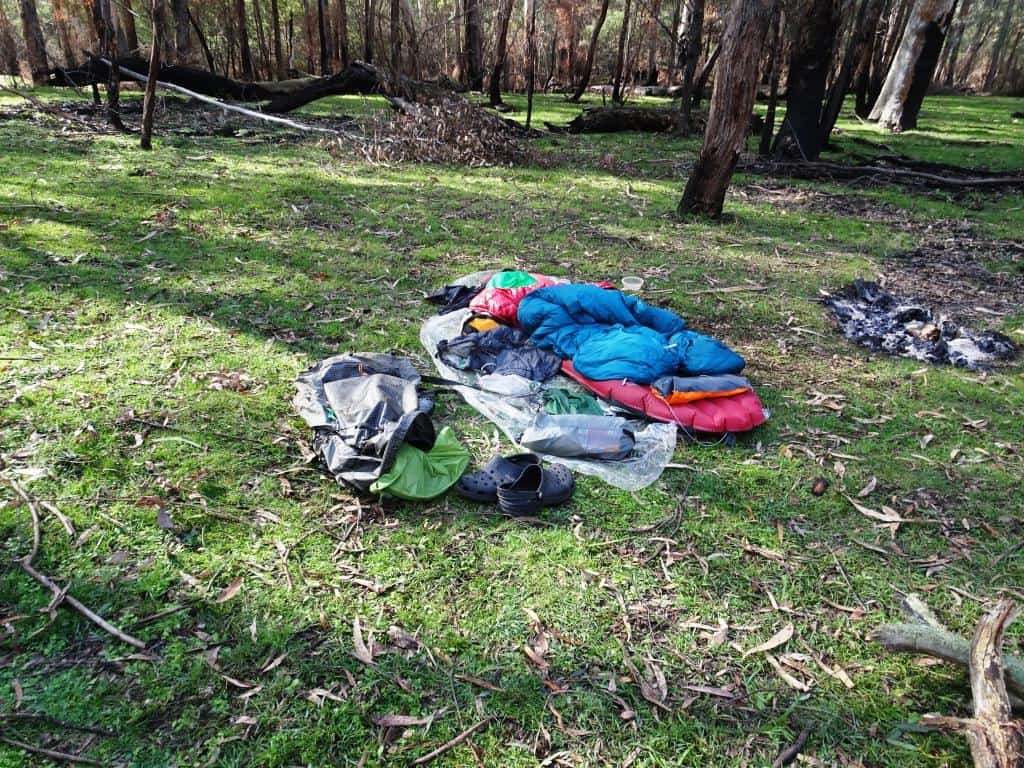
There is just so much destruction. This used to be such a pretty little valley:
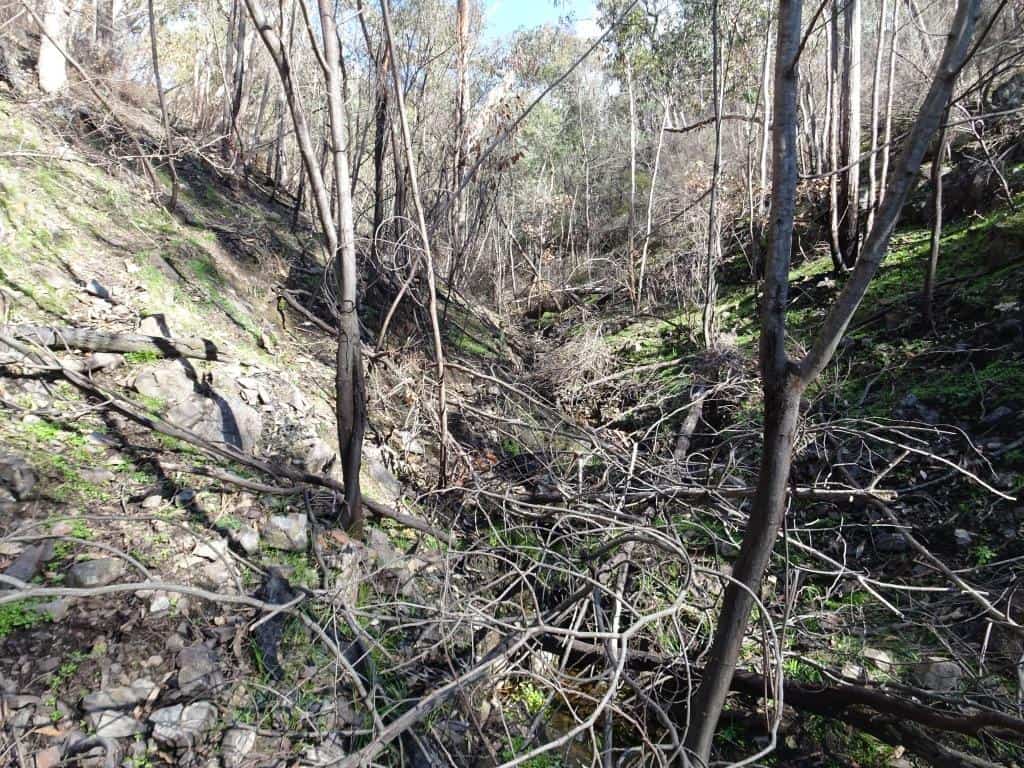
One plus I guess is that you can now see (but not for long!) some of the C19th pack tracks which had completely disappeared into the bush. DOC or Parks Vic (whoever they are) could give some thought to keeping them open as hiking trails – but I doubt this will happen as they never get out of their cars or offices and into the bush, so they wouldn’t know or do anything if they did! These pack tracks are everywhere in the Victorian bush (wherever there were miners anyway), as so much stuff had to be transported on horseback or wheel barrow. Most places they are hard to notice. Of course there are innumerable overgrown old timber trails now too.
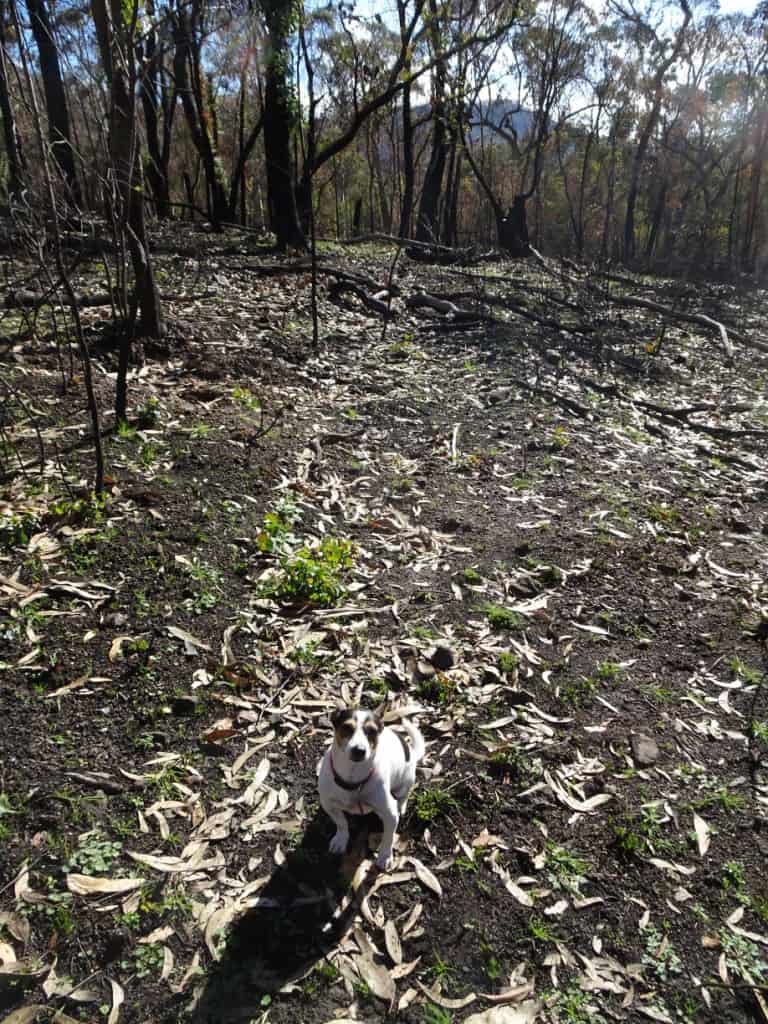
Here we were just having lunch, hoping that some Voyageurs, some canoeists would come along and give us a lift out. Worse luck we had a couple more days walking. Lichen is wonderful.
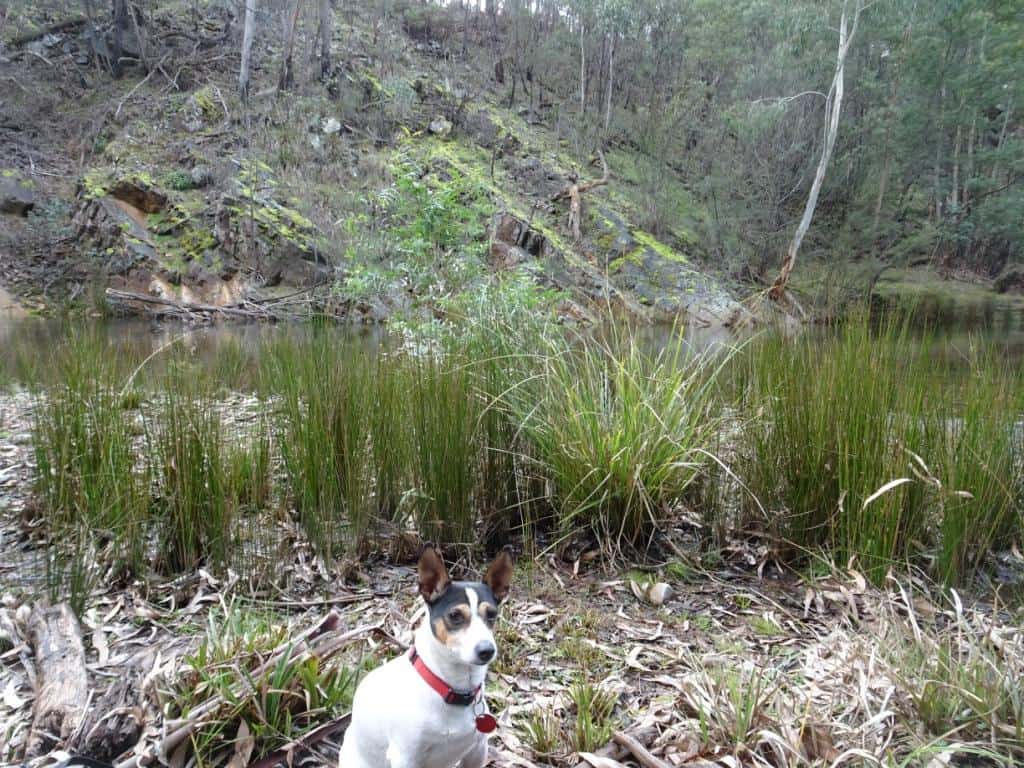
Many deer have survived the fire but most are not in great condition. I found a dead hind in fairly ordinary condition who had probably died of pregnancy toxemia and a poddy who had probably starved to death – this long after the fire. It stayed pretty dry for a long while after the fire (I know we were hand feeding our sheep from mid summer until very late autumn – in a better rainfall distriict) so that regrowth was a long while coming on. It is there now but is really what farmers like me call a ‘green drought’. The bush will be suffering the effects of this neglectful fire for a generation or more!
If you have been reading this blog for a while you might remember Tiny’s deer from many years ago.

It had disappeared into the forest floor. The fire had uncovered its bones. Gave me quite a sentimental journey I can tell you what with Tiny now dead these two years past after having shared the planet with me for 18 years. You and I will go the same way too soon enough. Tempus fugit my old son. Time to carpe that old diem. Spend a few days hunting now rather than later. Cheers, Steve.
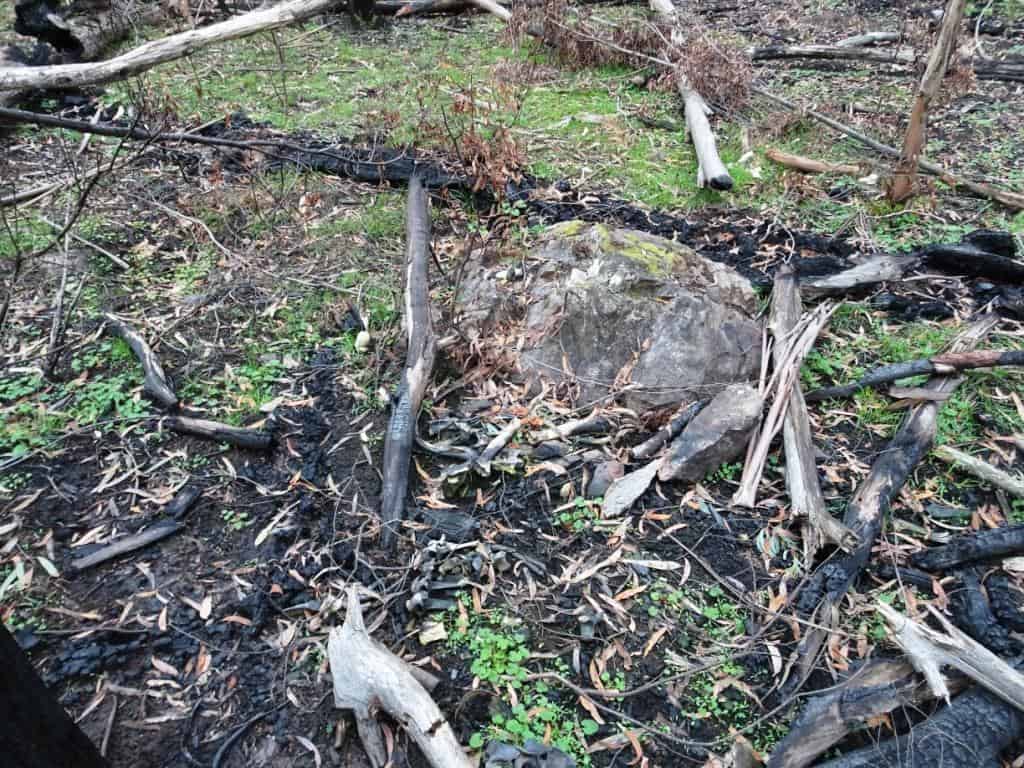
See Also – and don’t forget the many links I have placed in the text above:
https://www.theultralighthiker.com/2015/06/15/sambar-stalking-101/
https://www.theultralighthiker.com/2018/05/20/the-deer-hunters-apprentice-1/
https://www.theultralighthiker.com/2017/10/28/the-ultralight-deer-hunter/
First Published on: Jul 30, 2019
I am still visiting this wonderful part of the world:
See: Hunting the Wonnangatta Again

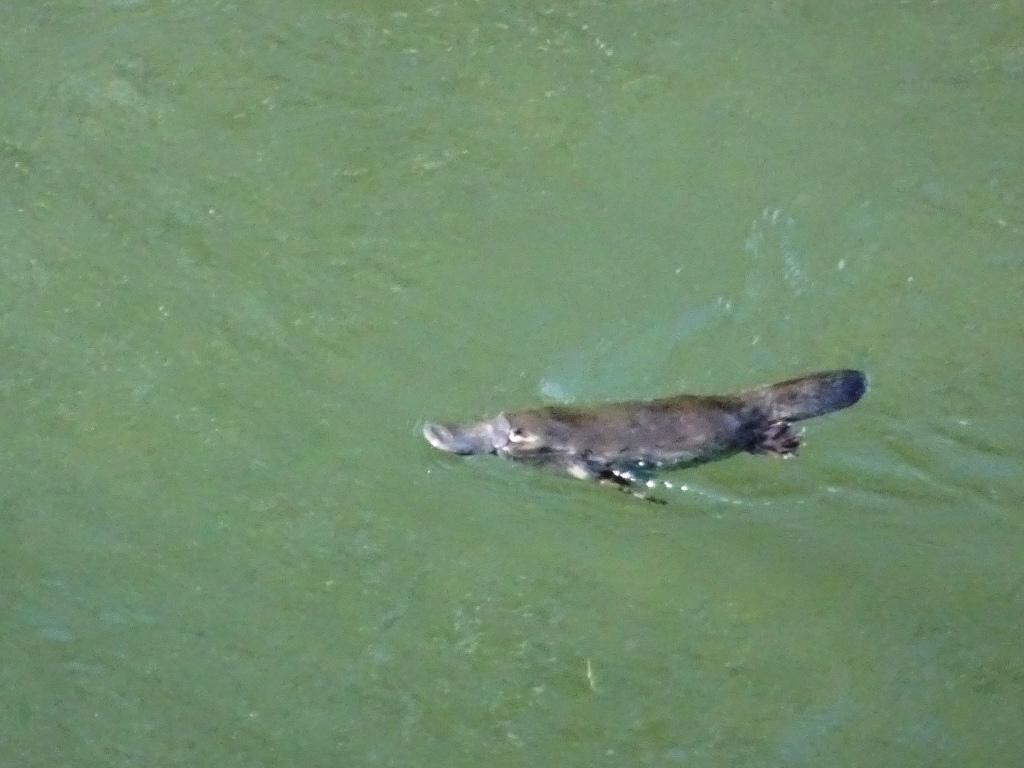
I would like to echo Scott’s sentiments. I enjoy your articles and have assisted me in selecting new light weight equipment. Especially the ability to purchase from the US. Keep up the good work.
Thank you also Alan. Perhaps you should also move to trying to make more of your gear yourself? Not only is it rewarding in itself and a boost to self-confidence, it also saves lots of money. I am shortly going to have another go at the Forester tent myself. Because it is flat it can all be cut from a single piece (eg of blue poly tarp). With a couple of small ‘wings’ for doors it makes just about the best shelter that exists – and can be made for less than $20. A piece of polycro for the floor, and you’re off!
Happy Birthday Steve. I love and appreciate your site and all your great articles and I hope theres many more to come!
All the best
Thank you so much for your kind thoughts Scott. I hope so too. Cheers, Steve.